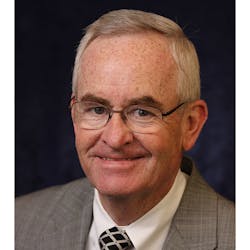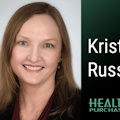Supply chain opportunities and new perspectives
This month we deviate from our usual news format to cover content featured during a keynote presentation that emcompassed many of the challenges our healthcare supply chains continue to deal with due to the pandemic. In addition, there were enlightening stories about partnerships with local businesses developed by hospitals, that helped the community and the hospital systems, and promoted diversity and equity initiatives.
One of the partnership stories was shared by Richard Bagley M.B.A, CPSM, PMP, Senior Vice President & Chief Supply Chain Officer, at the Penn State Health about their Milton Hershey Medical Center. Bagley spoke passionately about about how The Hershey Company donated 22,000 square feet of new warehouse space. The new “KISS” warehouse helped the hospital system manage their incoming pandemic inventory for everything from hand sanitizer to disinfectant wipes and Personal Protective Equipment (PPE). Hershey even supplied six employees to help. This wasn’t the only story of heroic and innovative partnerships we heard at this years Spring IDN Summit. As a result, Healthcare Purchasing News would love to continue to share these types of partnership stories that illustrate the impact of successful diversity and equity partnerships with their communities. Please send them to [email protected].
Building successful relationships
An IDN Summit Executive Leadership panel featured a quartet that explored how Supply Chain can empower opportunity, and offered new perspectives on operations. Brent Johnson, retired Vice President Supply Chain at Intermountain Healthcare, led his former colleagues Richard Bagley, Kreg Koford, Senior Vice President of Supply Chain and Hospital Operations at Memorial Sloan Kettering Cancer Center, and Joe Walsh - Coach, Educator, & Advisor at Supply Chain Sherpas, in a lively and insightful discussion around the supply chain’s elevation to a visible, strategic player in healthcare’s future sustainability. All four were instrumental in making Intermountain Healthcare a perennial top performer before moving on to other successful supply chain operations
The COVID crisis has made supply chain a conversation topic in every household, while thrusting healthcare supply chain into the national spotlight. Supply chain functions now have the attention of the country, but with this new level of strategic relevance, awareness and support, how will we show up? And how will we go forward at this unprecedented inflection point?
The conversation began with a question on how much the industry had really changed over the past several years. An informal survey conducted by Brent Johnson, reported that responders felt very little had changed, others saw skill sets that had greatly improved, along with the elevation of supply leaders in importance and stature. Other respondents pointed to an emphasis on strategic value and the importance of a resilient supply chain.
But how much of that change was driven out of necessity by the pandemic? It’s hard not to recognize the changes that came from COVID – things like telehealth, remote work, risks of single sourcing, the true value of logistics, etc. In general, the experiences of the past two years have highlighted the challenges in healthcare supply chain management we have known about for some time. But now there is an increased sense of urgency.
There is no denying, COVID has served as a catalyst for change for the healthcare supply chain, in some ways, highlighting the vulnerabilities, and exposing the flaws of certain long-held strategies. But, as pointed out by Walsh, it created the means for supply chain to access “the spotlight we’ve always been asking for.” He shared that supply chain now has the undivided attention of the C-suite. “There’s new measures of success. Supply chain resiliency matters as much as cost reduction. Attitudes on working remotely have changed,” he said. “Now the question is, what are we going to do?”
Identifying opportunities
Bagley referred to the current atmosphere as the perfect convergence of opportunity, motivation and capability for supply chain.
Walsh also clarified, “When we say supply chain, we’re talking about everyone in this room – providers, your GPO, distributors, manufacturers, solution providers, we’re all supply chain.”
Bagley also focused on some perspectives that had been changed over the course of the past two years. Specifically, how nimble supply chain could actually be when there was need. Rather than focusing on endless committee discussions and bureaucracy, “If you’ve got the right product that can fill the right need, we can make decisions faster than I’ve ever seen in my lifetime,” he said.
What are the pillars of success?
With these new opportunities and perspectives, what are the pillars of success that will allow supply chain to capitalize and truly advance its standing? The panel focused specifically on five: alignment, talent, relationships and communication, and strategies.
AlignmentKoford began the alignment discussion stressing the importance of being an equal partner with organizational leadership in the overall strategy. He stressed that the new supply chain leader must bridge the gap through the entire organization and understand the overall strategy, reinforce the impact of supply chain, and leverage that to gain the talent, optimization and the technology necessary. As an example, Koford cited the investment his organization, Memorial Sloan Kettering, made in demand planning. That investment, he said, has proven invaluable, “Paying dividends throughout the pandemic, providing the capability to pivot, leverage some of the insights gathered, and learn on the fly so that we could be more proactive.”
Walsh shared a cautious note around the subject of alignment, stressing that supply chain shouldn’t be subservient to any of the agendas of the CFO, CMO or even the CEO. “Haven’t we just proven that supply chain is equal to the agenda of the CFO, equal to the agenda of the CMO and equal to the agenda of the CEO?” he said. “It’s time to actually elevate the supply chain agenda into the boardroom sitting next to those leaders. Otherwise, I fear that no matter where you align supply chain, you’ll always actually be serving somebody else’s agenda, and actually missing the bigger picture.”
TalentKoford followed up with the need for investment in talent and the critical nature of having a talent strategy, especially with a national workforce that can work remotely. He emphasized building a strategy with leadership teams that are constantly learning and adapting to trends in the larger healthcare, political and business environments, so that they’re not stagnant.
Of course, obtaining exceptional talent necessitates the ability and willingness to pay for it. “Today, every major university in the United States has an MBA supply chain program, or supply chain emphasis” said Johnson. “If we don’t pay what the supply chain MBAs are getting in other industries, we’ll never get them.”
As part of talent, Walsh talked about the concept of “leadership preparedness,” similar to, or part of, emergency preparedness. “We’ve got to have the right skill sets as leaders and we’ve got to have the right mindset to educate teams on the fundamentals of sourcing,” Walsh emphasized. “They have to know how to do tactical sourcing, category management, and they have to know how to do procure to pay the right way.”
Bagley added, “You need to upskill your talent, including your own, to lead us to where we need to get to, which is a stable supply chain,” he declared. “So, when people in your community come to you for help, the products and equipment that are needed to deliver the best quality care, are there.”
RelationshipsWhen discussion turned to relationships, the panel stressed that another byproduct of the challenges of the past two years was redefining value when it came to relationships. “I think during the pandemic, one of the things that contributed to our success was the ability to call on key suppliers and understand capabilities, solutions, and where things stood, with transparency and honesty,” Bagley said.
Rather than just beating each up over price, providers, suppliers and GPOs need to strive for deeper, interconnected relationships that stress shared responsibility and accountability, with a focus on the end user and meeting the needs of caregivers and patients. Bagley suggested measuring supply chain through the eyes of the customer. “How does it feel when you don’t have what you need, or you have to change what you’re used to?” he asked.
Bagley continued, “I think we’ve learned as well, that outsourcing our strategy to third parties that aren’t invested in our communities is not a pathway forward.” He cited several examples of partners in the community and suppliers who maintained transparency and a spirit of interconnected success, rather than a strictly lowest price, transactional approach.
Strategies & momentumWalsh defined strategies as encompassing people, processes, technology and governance, across the three pillars of supply chain including sourcing, procure to pay and operations. He stressed the need for a roadmap, or short and long-term strategic plan, that will actually move the needle and improve those areas over time, being adaptive and proactive for changes and disruptions similar to what we have experienced.
“Our sourcing strategies have to adapt. We have learned sole source agreements are not the right answer in every situation. We’ve learned just in time inventory may not be the right answer in every situation,” he continued. “Our inventory strategies and rethinking just in time, low unit of measure to right size, what that should look like?”
As the discussion wound to a conclusion the panelists were emphatic in imploring the audience to capitalize on the game changing opportunity. “I hope that we can leverage this to build the supply chain future that we need,” said Bagley. “My challenge to you. Get invested in your local community, and your local healthcare. And if you’re a supply leader, redefine what success looks like and focus on enabling our clinicians to be at the top of their game.”
Walsh concluded by saying this same imperative applies to those on the supplier and GPO side as well. “You have to sell into providers in a very different way than you’ve sold into providers previously,” he said. “You have to be informed about your supply chain, and what you’re capable of doing in a very transparent way.” He stressed that means internally, working closely with supply and operations teams, to have a standard operating procedure (SOP) process that maybe didn’t exist previously.
“The days of going around supply chain and going to clinicians to get their approval are long gone,” he stated. “Right now, supply chain is in the middle of every one of those conversations. I always say ignore supply chain to your peril. ”
Honoring a legend
In accepting the award, a humbled Johnson took one final opportunity to elevate the supply chain profession and reinforce the panel’s message. “I’m honored. But it’s not about me, it’s about you,” he said. “It’s about everybody that is trying to improve supply chain in the healthcare industry. It is our time. It’s the right time. Do something with it. Don’t just sit and do the same old stuff. Make a difference and do something with this change and opportunity.”
About the Author
Kristine Russell
Publisher Emeritus
Kristine Russell is Publisher/Executive Editor, Retired
Healthcare Purchasing News, EVP, Healthcare Division, Endeavor Business Media LLC.


